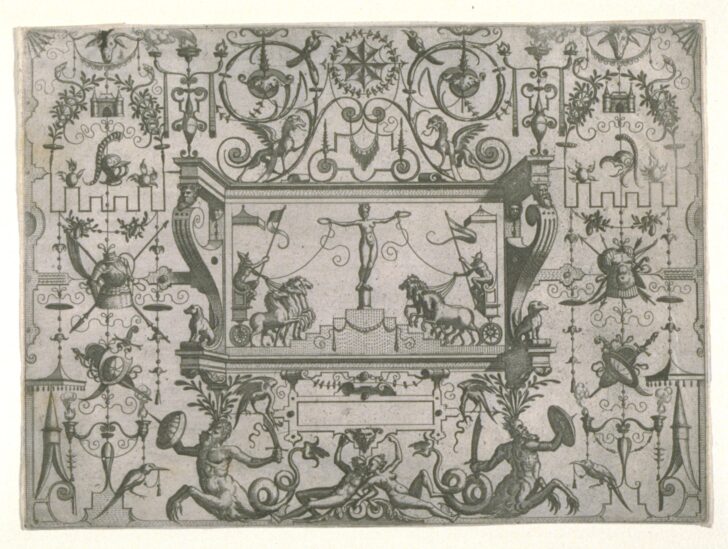Ornament Print from a series: ‘Grottesco in diversche manieren’
Hans Vries

Description
Gallery Rotation Spring/Summer 2012
Hans Vredeman
de Vries
Netherlands, 1527–circa 1606
Ornament print, from Grottesco in diversche manieren
1555–60
Engraving
Museum purchase, 1960/1.118
In addition to being a visual artist, Vries was a designer, architect, engineer, and inventor. His interest in designs for interiors and architectural elements led him to publish a series of books on ornamental illustration, one of which was Grottesco in diversche manieren. This print shows Vries’s skill and attention to detail, but also his command over the style of decorative ornamentation known as grotesque.
A French term derived from the Italian grottesco, grotesque describes a type of European ornament comprised of intricate motifs combining scrollwork, architectural elements, and a mixture of fanciful human figures and fantastical, mythological creatures; it is encountered most often in the decorative and graphic arts. The word originated as a descriptive term for the mural decorations inspired by the Ancient Roman wall paintings unearthed at the Domus Aurea (Golden Palace of Nero) around 1500. Because the site was beneath street level when it was rediscovered, it was believed the rooms were built as caves or grottos, a misunderstanding that not only led to the naming of the style but also to its association with the primitive, the pagan, and the natural.
Subject Matter:
Such elaborate decorative works filled with fantastical motifs were inspired by the discovery around 1500 in Rome of Nero's Domus Aurea (Golden Palace), the interior of which was filled with similar elaborate wall paintings.
Physical Description:
Within an elaborate decorative framework consisting of griffins, birds, dogs, and fantastic half man-half beast creatures is a central panel with the image of a nude woman standing on a column holding a victor's wreath in either hand. Approaching for either side is a man in a quadriga holding a banner; each also holds a line that extends up to the wreath in the woman's hand.
Usage Rights:
If you are interested in using an image for a publication, please visit https://umma.umich.edu/request-image/ for more information and to fill out the online Image Rights and Reproductions Request Form.